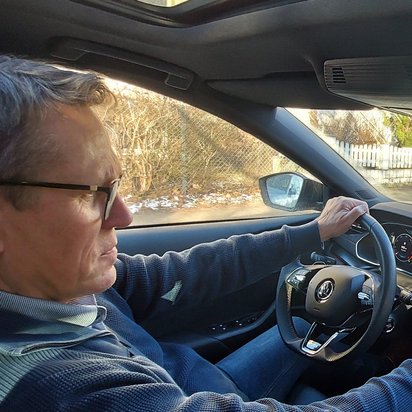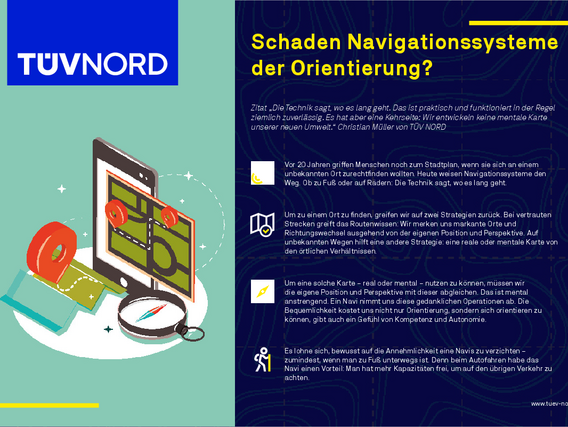Damage to the navigation system
Mobility: Mit einem Navigationsgerät kommen wir auch in fremder Umgebung schnell zum Ziel. Aber ohne Navi lernen wir mehr.

Mobility: Mit einem Navigationsgerät kommen wir auch in fremder Umgebung schnell zum Ziel. Aber ohne Navi lernen wir mehr.

20 years ago, people still used a city map when they wanted to find their way around an unfamiliar place. Today, navigation systems show the way. Whether on foot or on wheels: The technology tells you where to go. This is practical and usually works quite reliably. “But there is a downside,” says Christian Müller from the Medical-Psychological Institute of TÜV NORD in Cologne. “We don't develop a mental map of our new environment.”
Researchers first discovered that such “cognitive maps” exist in the middle of the 20th century in experiments with rats: In a maze, they quickly found their way to food even when the only path they knew was blocked. Apparently, they also had the surroundings in their heads and were thus able to find new paths. The animal experiments showed that such mental maps are stored in the hippocampus and the neighboring entorhinal cortex, two structures deep inside the brain that are also involved in other long-term memories. There are even specialized cells there that represent a specific location.

People orient themselves in a similar way. We generally use two strategies to find our way to a place, explains psychologist Christian Müller. One: “We memorize prominent places and changes of direction based on our own position and perspective, for example: turn right behind the town hall.” However, this so-called route knowledge only helps if we are traveling on a familiar route. That's why we need a different strategy on unfamiliar routes: “a real or mental map of the local conditions.”
To be able to use such a map - real or mental - we have to compare our own position and perspective with the map. This is mentally exhausting. A navigation system relieves us of these mental operations. As a result, we don't learn to find our own way and only develop rudimentary ideas of our surroundings. “Automatic wayfinding erodes our natural abilities,” warned Roger McKinley from the British Royal Institute of Navigation in the journal Nature in 2016. If you don't use it, you lose it: “Use it or lose it!”
For the brain to learn optimally, it has to work actively. It is not enough to blindly follow instructions, as a team led by German psychologist Stefan Münzer discovered. The group equipped young adults with various navigation aids during their first visit to Saarbrücken Zoo: either a mobile computer with a navigation function or a simple map. After their visit to the zoo, they were asked surprising questions: Where was what, where had they turned off? On average, those with a map were able to remember better.
Another time, Münzer and his team took test subjects for a walk around a university campus. One group was again given a navigation device that showed the correct route, while the others were only given a navigation device that showed their position on a map. They were also surprised with a test after the campus visit. Those who were guided by the satnav were less likely to get lost. But those who only had the position display drew a better map of the university campus afterwards.
Driving is no different. Israeli traffic researcher Eran Ben-Elia equipped his test subjects with either a traditional map or the Google Maps app and sent them to a destination in an unfamiliar area in their own car. They were then asked to describe the route, give directions and recognize landmarks: In all respects, the group that had to make do with a paper map was better.
“Convenience doesn't just cost orientation,” says psychologist Christian Müller from TÜV NORD. “Being able to find your way around also gives you a sense of competence and autonomy.” That's why it's worth consciously foregoing this convenience - at least when you're on foot. After all, sat navs have an advantage when driving: “You have more capacity to pay attention to other traffic. That's why sat navs can be the safer alternative.” However, he recommends memorizing the route on a map in advance. That way, you can find your way around better in an emergency and know alternative routes or at least the rough direction. Relying solely on the GPS is not a good idea anyway. “Death by GPS” is now a field of research in its own right, because people keep blindly following their GPS.
Founded over 150 years ago, we stand for security and trust worldwide. As a knowledge company, we have our sights firmly set on the digital future. Whether engineers, IT security experts or specialists for the mobility of the future: in more than 100 countries, we ensure that our customers become even more successful in the networked world.